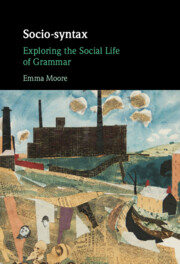Book contents
- Socio-syntax
- Socio-syntax
- Copyright page
- Dedication
- Contents
- Figures
- Tables
- Acknowledgements
- 1 Why Does the Social Meaning of Grammar Matter?
- 2 The Social Landscape of Midlan High
- 3 How Do We Study the Social Meaning of Grammatical Variation?
- 4 How Free Are We to Vary the Grammar We Use?
- 5 How Do We Use Grammar to Design Our Talk?
- 6 Does Everyone Use Grammar to Make Social Meaning?
- 7 How Does Grammar Combine with Other Elements of Language?
- 8 What Does It Mean to View Grammar as a Fluid, Flexible Social Resource?
- References
- Index
7 - How Does Grammar Combine with Other Elements of Language?
Published online by Cambridge University Press: 19 October 2023
- Socio-syntax
- Socio-syntax
- Copyright page
- Dedication
- Contents
- Figures
- Tables
- Acknowledgements
- 1 Why Does the Social Meaning of Grammar Matter?
- 2 The Social Landscape of Midlan High
- 3 How Do We Study the Social Meaning of Grammatical Variation?
- 4 How Free Are We to Vary the Grammar We Use?
- 5 How Do We Use Grammar to Design Our Talk?
- 6 Does Everyone Use Grammar to Make Social Meaning?
- 7 How Does Grammar Combine with Other Elements of Language?
- 8 What Does It Mean to View Grammar as a Fluid, Flexible Social Resource?
- References
- Index
Summary
Syntactic variants are contentful: they don’t just differ by their syntactic structure, they also differ by their lexical content and, in speech, by their phonetic content. Do these different levels of linguistic architecture work individually or synergistically to create social meaning? By examining tag question constructions (like ’He were bad, though, weren’t he?’), this chapter shows how grammatical environment can work synergistically with other levels of linguistic architecture – including phonetics – to create social meaning. In modelling how to examine all of the linguistic characteristics of a syntactic item, this chapter shows how we might better integrate the study of syntactic variation into a wider understanding of the social meaning of language more generally. It also explores whether the universality of syntactic variables like tag questions (i.e., variables that everyone uses to some extent to express interactional positioning) means that they do not acquire the types of social meanings found for other linguistic variables.
- Type
- Chapter
- Information
- Socio-syntaxExploring the Social Life of Grammar, pp. 171 - 206Publisher: Cambridge University PressPrint publication year: 2023



